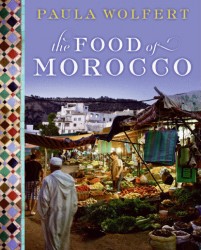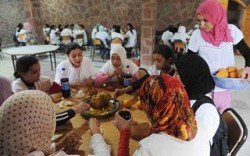 Innocently, but very interested, I asked a question on “Moroccan Cooking” a FaceBook page started by Paula Wolfert. The question was ‘when an identifiable cuisine that could be called Moroccan appeared’. The year 711 was her answer, and then she kindly included pages 3-7 from her first book on Moroccan Food, “Couscous and Other Good Food From Morocco” (copyright 1973, Paula Wolfert, Quill Press). Not only does she clearly define what makes a great cuisine, but you’ll get a short primer on what has influenced Moroccan cooking and why she picked 711.
Innocently, but very interested, I asked a question on “Moroccan Cooking” a FaceBook page started by Paula Wolfert. The question was ‘when an identifiable cuisine that could be called Moroccan appeared’. The year 711 was her answer, and then she kindly included pages 3-7 from her first book on Moroccan Food, “Couscous and Other Good Food From Morocco” (copyright 1973, Paula Wolfert, Quill Press). Not only does she clearly define what makes a great cuisine, but you’ll get a short primer on what has influenced Moroccan cooking and why she picked 711.
With Paula’s kind permission, I’m including this very interesting background. Her criteria for what makes a great cuisine can be applied to the old world cuisines, but may point out that today’s “modern cuisine” doesn’t actually qualify…history being the qualifier.
I’d love to hear your thoughts in the comment box at the end of the article.
“The Prerequisites for a Great Cuisine
To my mind four things are necessary before a nation can develop a great cuisine. The first is an abundance of fine ingredients-a rich land. The second is a variety of cultural influences: the history of the nation, including its domination by foreign powers, and the culinary secrets it has brought back from its own imperialist adventures. Third, a great civilization-if a country has not had its day in the sun, its cuisine will probably not be great; great food and a great civilization go together. Last, the existence of a refined palace life- without royal kitchens, without a Versailles or a Forbidden City in Peking, without, in short, the demands of a cultivated court-the imaginations of a nation’s cooks will not be challenged.
Morocco, fortunately, is blessed with all four. In its ever-changing landscape and geographical situation are riches that rival those of France. Situated in the northwest corner of Africa, only a few miles across the straits from Europe, with a Mediterranean coast and an Atlantic coast, with green fertile agricultural belts, five mountain ranges, and encompassing areas of desert, Morocco has every type of environment except tropical jungle. In this small but highly variegated space some of the finest raw ingredients may be found. There are the mint, olives, and quinces of Meknes; the oranges and lemons of Fez and Agadir; the pomegranates of Marrakesh; the almonds, lamb, and za’atar ofthe Souss; the dates of Erfoud; the shad of the Sebou River (PW note-sadly, in 2011, they no longer do); rosebuds from the Valley of Dades; walnuts, chestnuts, from the Rif; Barbary figs, also
known as prickly pears, from the region of Casablanca; the honey of Tagoundaft; the barley of the Dra; the cherries of Sefrou; the melons of the Doukkala; the fish caught by the men of Essaouira; the seafood collected by the men of Safi; and the spices that for thousands of years have been brought to this country, first by Phoenicians, then by Senegalese traders and caravans that crossed North Africa from Arabia, the Sudan, and the Middle East. It is all there-Morocco is, literally, a land of milk and honey.
As for cultural influences, there have been an enormous number. The in-digenous culture is Berber, and Berbers still constitute a good 80 percent of the people. (Berbers are not Arabs; ethnically they are Harnites with a suspected Nordic strain* but they embrace Islam, and it is in fact this common religion that holds the country together.)
In 683 Morocco was invaded by Arabs in what the painter-writer Brion Gysin has so aptly called the “Damascus Thrust.” An Arabian conqueror named Ogba ben Nafi reached Morocco in that year, and his invasion was followed by other waves of Arabs bringing the religion of Islam and the cultural influence of Arabia and the Middle East.
The Arabs, as everyone knows, went on to conquer Spain. Their Spanish empire, known as the Andaluz, founded in 711, produced a great and delicate culture, less strong in terms of military might than the kingdom of Morocco, but perhaps more graceful, excelling in such refinements as the art of courtly love and magnificent architectural feats. (Some of the greatest buildings in Morocco, the Koutoubia Mosque in Marrakesh, for example, were designed by Andalusian architects.) For centuries there was cultural exchange between Morocco and Muslim Spain; their reciprocal influences were perhaps as great as the original influence of their Arabian invaders.
Each of the great dynasties of Morocco-the Almoravides, the Almohades, the Merinides, the Saadians, and the Alaouites-included, at one time or another, kings whose power went far beyond the borders of present-day Morocco. Idriss II, the son of an Arabian shrif, founded Fez in the ninth century, and for hundreds of years that city was known as a center of Arab culture. The Almoravides, whose king Yusuf ibn-Tashfin (1061-1106) founded the city of Marrakesh, possessed an empire that encompassed half of Spain, more than half of Algeria, and extended as far south as Senegal. The Saadians were powerful as far south as Timbuktu, and Moulay Ismail (1672-1727), the man who built Meknes, was highly regarded by Louis XIV, with whom he ex- changed many letters, including pleas that le Roi Soled convert to Islam.
Morocco, on account of the invasions of Arabs and the exterior adventures of Moorish kings, was strongly influenced by Middle Eastern culture and the culture of the Andaluz. The Arabs learned culinary secrets from the Persians and brought them to Morocco; from Senegal and other lands south of the Sahara came caravans of spices. Even the Turks made a contribution; though their sixteenth- century North African conquest did not penetrate Moroccan territory, their cultural influence was felt within its borders.
 From a culinary point of view these cultural influences can be seen quite well in the three gastronomic centers of the land. In the Berber city of Marrakesh the food is basically Berber, with a Senegalese and African influence. In the Arab city of Fez the cuisine shows the influence of the Andaluz. And in the Andalusian city of Tetuan the Spanish influence is strongest, with some Ottoman traces. Portuguese influence may be found in the cuisine of the Portuguese settlement cities on the Atlantic coast, and here Essaouira, a city of white buildings and blue shutters, became the home of a large Jewish population who worked out their own variations on the national cuisine. The Moroccans picked up tea-drinking from the British traders; and the French, from the forty-four years (1912-1956) of their protectorate, left behind some Gallic touches. There are indeed an enormous number of outside influences; the African spice meets the Andalusian chick- pea, the Saharan date confronts Middle Eastern pastry, Berber butter competes with Spanish oil-and then all merge to become Moroccan food.
From a culinary point of view these cultural influences can be seen quite well in the three gastronomic centers of the land. In the Berber city of Marrakesh the food is basically Berber, with a Senegalese and African influence. In the Arab city of Fez the cuisine shows the influence of the Andaluz. And in the Andalusian city of Tetuan the Spanish influence is strongest, with some Ottoman traces. Portuguese influence may be found in the cuisine of the Portuguese settlement cities on the Atlantic coast, and here Essaouira, a city of white buildings and blue shutters, became the home of a large Jewish population who worked out their own variations on the national cuisine. The Moroccans picked up tea-drinking from the British traders; and the French, from the forty-four years (1912-1956) of their protectorate, left behind some Gallic touches. There are indeed an enormous number of outside influences; the African spice meets the Andalusian chick- pea, the Saharan date confronts Middle Eastern pastry, Berber butter competes with Spanish oil-and then all merge to become Moroccan food.
The greatness of Moroccan culture? This nation had its days when its influence radiated thousands of miles from Fez, a city that was preeminent in theology, astronomy, medicine, mathematics, and metallurgy when Europe was deep in the Middle Ages. Fez was an Athens, a city of enormous vitality and refinement, and Moroccan knowledge of agriculture and irrigation (Marrakesh is basically a huge grove of palms, an enormous man-made oasis) made Spain flourish. In fact, after the fall of Granada and the final expulsion of the Moslems from Spain in 1492, Spanish agriculture began to suffer a reversal.
The high culture of Fez was developed in parallel with the rich folk culture that had strong Berber origins: that mad charge of horsemen known as the fantasia; Berber trance-dancing; the great Berber pilgrimages (moussems), which are today important tourist attractions; folk music and poetry; and the basic cuisine of the mountains and plains.
This cuisine would certainly be worthy of attention even on its peasant level, but, as developed in the kitchens of the royal palaces of Fez, Meknes, Marrakesh, and Rabat (the four royal cities), it reached summits of perfection. The Moroccan dynasties always originated in powerful warlike tribes, whose leaders, as soon as they obtained power, were quickly refined. Thus the Saadians, who came from the pre-Saharan Valley of the Dra, were transformed from primitive tribesmen into regal monarchs, their tombs in Marrakesh being among the most lavishly decorated in all Morocco. (The garden of these tombs, by the way, is filled with a glorious ambrosia, the result of high, thick hedges of rosemary.) In the same way, in our own time Thami el Glaoui, whose power rivaled and sometimes exceeded the power of the sultan, was transformed from a feudal warlord of the High Atlas stronghold of Telouet, into the pasha of Marrakesh; friend of Winston Churchill, he dealt with premiers and presidents of France, and moved, in the latter half of his long, ruthless, and now generally discredited life, in the most civilized and refined international circles.
These monarchs and lords, as soon as they learned to entertain in regal style, began to make great demands upon their chefs to produce some of the great cosmopolitan specialties of Morocco. A case in point is bisteeya, which had humble origins in a simple Berber dish of chicken cooked with saffron and butter. It was combined with the primitive Arab pastry called trid, enhanced when later Arabs brought the fine art of Persian pastry making to Morocco, and was further embellished with Andalusian ideas until it became the bisteeya we know today.
People still speak with awe of the food served in the king’s house. One hears rumors of “mounds of pigeons” each differently stuffed, flowing to diners on golden platters and then being whisked away, only to be replaced by equally luxurious foods. Meknes, a royal city conceived like Versailles as a place devoted to court life, was where much of modern Moroccan cooking reached its final form.”
Copyright 1973 Paula Wolfert – Used by permission
* C. G. Seligman, Races of Africa, London: Oxford University Press, p. 119.
